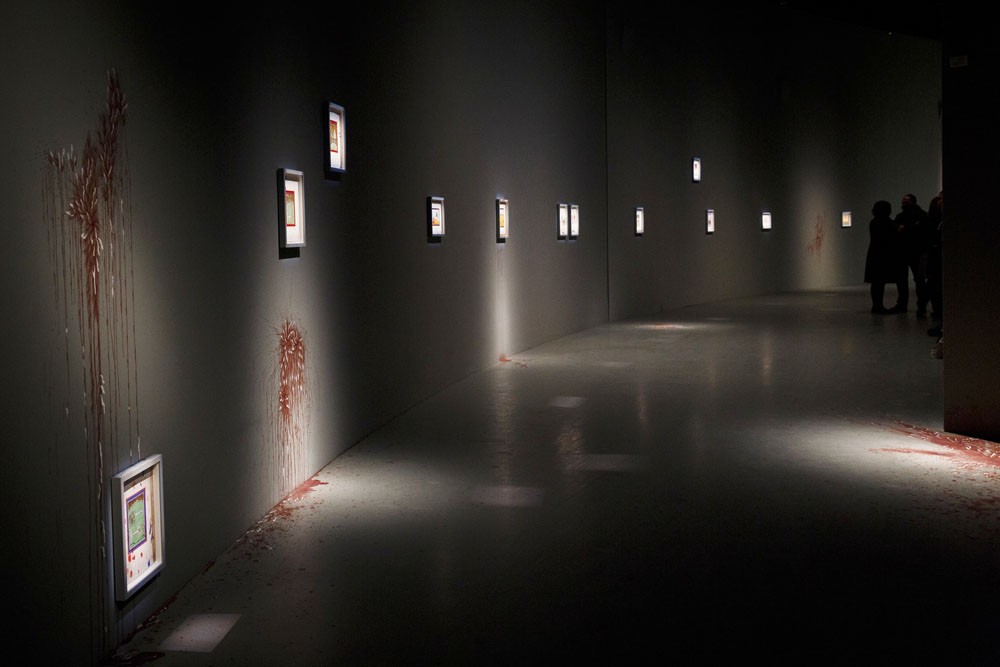
An important and evocative world premier of Imran Qureshi’s first major solo ongoing show in London at The Curve, Barbican

The leaden-grey concrete gallery at the Barbican offers an enticing, uninterrupted space spanning ninety metres, enabling visitors to tentatively grapple with the light adjustment whilst walking deeper into shadow.
At first glance it is tempting to be ensnared by clichéd terminology as we are seduced by these exquisite jewel-like miniatures curving along the crescent-shaped wall. However as you walk along, you notice how the splintered light draws you in towards the paintings, climbing up walls and down to the floor in the cavernous space -- a mesmeric pull that allows the audience to absorb the macro- and micro-scale of Imran Qureshi’s breath-taking, site-specific work.
Barely stopping to breathe as the eyes acclimatise in the dark, one sidesteps the splashes on the floor and walls that appears to be stains of blood, or are they vermilion hues that play tricks on the eyes? Through Qureshi’s extraordinary and perceptive lens, there is a union of beauty and suffering that goes beyond the aesthetics of Miniature and the sphere of a social commentary depicting the fragile world in which we inhabit.
Commissioned by the Barbican, this is the world premier of Qureshi’s first major solo show in London. The title, Where the Shadows are so Deep, is inspired by the poetry of Faiz Ahmed Faiz, a revolutionary, friend of Pablo Neruda and Pakistan’s national poet, and the sentiment of the title reverberates off the curved walls.
Qureshi is one of Pakistan’s leading artists and has achieved recognition in the global art scene. Born in Hyderabad, Pakistan in 1972, Qureshi was made ‘Deutsche Bank Artist of the Year’ in 2013 with an exhibition at the Ikon Gallery, Birmingham. Recent international exhibitions include a site-specific installation for the opening of the Aga Khan Museum in Toronto (2014), Imran Qureshi: The God of Small Things at the Eli and Edythe Broad Art Museum in Michigan (2014) and The Roof Garden Commission at The Metropolitan Museum of Art in New York (2013). He participated in the Venice Biennales in 2013 and 2015, was commissioned by Art on the Underground in 2014 and produced a major installation for Sharjah Biennial in 2011.
Qureshi continues to teach at the prestigious National College of Art in Lahore, which has earned a unique and exemplary reputation for propagating exciting and progressive interventions to the art of Miniature and for developing a crop of highly acclaimed artists.
In 2014, I curated a site-specific work by Qureshi commissioned for the Tour de France for the Yorkshire Festival in collaboration Mid Pennine Arts and Pennine Prospects at Baitings Reservoir, Ripponden. It was at this juncture I learned how early in his career, Qureshi was trained in performance. It is with this thought that the artwork at the Barbican feels like an immersive experience. The paintings are positioned at varying heights, invariably making the audience interaction with the artwork almost performative. Observing the dance-like movements of visitors conjures up images of the dancing figurines depicted by Matisse as their bodies stretch and bend, poised to see the work oscillating between the beauty and pain from floor to wall.
Seasoned miniature painter, Qureshi synchronously adheres to and defies the rules of the tradition. The exploration of the geo-political landscape cannot go unnoticed when examining the broader context of his artwork. Where do these crimson trails lead us? Across the conflict-ridden globe where displacement, protestations on tolerance and intolerance, nationhood and identity arise? Contrarily, this sense of precariousness has created a fertile climate for extraordinary art and artists to emerge. Qureshi’s work subtly allows the audience to connect with a deeply moving response not solely to the architecture of the hollow gallery metamorphosed into a space for reflection.
Amidst this fracture, with the use of wasli paper, ground pigments and formalised structures, the texture and application of Miniature painting evolving from 16th Century Persia and India has been preserved and adhered to. Contemplation is achieved by peering into windows of light, looking at the details of the borders and the landscapes, overshadowed by raining shards across the rich marigold, royal blue and turquoise-coloured heavens and figures. As we look to the walls, up to the ceiling and down to the floor, is it serendipitous where shards of light touch the gold leaf of the miniatures and, as an umbilical cord, appear to connect the earth through the broken branches of the trees to the sky -- like windows to the soul -- that we are reminded of a Sufi derwish tradition?
Where the Shadows are so Deep is an important and evocative exhibition that depicts the unimaginable with unspeakable beauty in the cycle of order, chaos and violence as experienced through the contemporary art of miniature. Qureshi’s work is experiential, timely and sincere. As the crescent reflects half the world, we encounter this work in our different terms as we seek remnants of hope, change and peace.